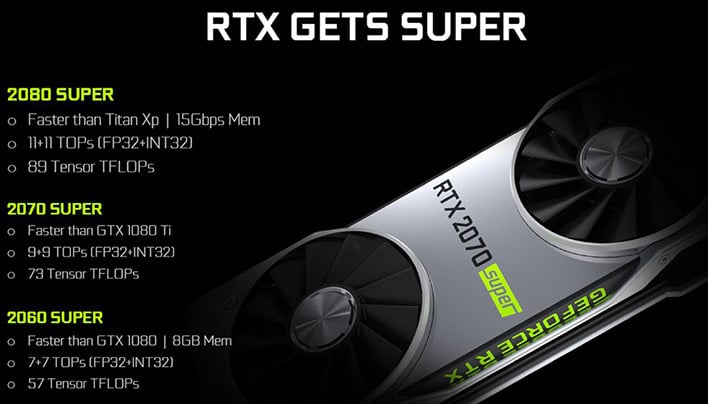GeForce RTX 2070 Super And RTX 2060 Super Review: Tricked-Out NVIDIA Turing
NVIDIA is overhauling its Turing-based GeForce RTX line-up with an array of “Super” GPUs, specifically the GeForce RTX 2060 Super, RTX 2070 Super, and RTX 2080 Super. In the short term, like two days from now, the GeForce RTX 2060 Super and RTX 2070 Super will hit store shelves. The GeForce RTX 2080 Super is coming in a few weeks though, and will arrive closer to the end of the month.
As their names suggest, all of the new Super GPUs are upgrades over their standard counterparts, but NVIDIA hasn’t completely re-invented the wheel here. The company has essentially tweaked core counts, clock speeds, and memory configurations, to boost overall performance. Take a look at the specs and our quick turbo video review below, and then we'll dig in much deeper on performance...
|
The table above compares and contrasts the original GeForce RTX 2060 and RTX 2070, with the new Super editions. As you can see, the GeForce RTX 2060 Super offers a number of upgrades over its predecessor. The RTX 2060 Super is still based on the TU106 GPU, but it has four additional SMs enabled, which brings the CUDA core count up to 2,176 (from 1,920). The RTX 2060 Super’s base clock is somewhat higher than the original, however, its boost clock is 30MHz lower at 1,650MHz.
The GeForce RTX 2060 Super is also outfitted with 16 additional texture units (136 vs. 120), its L1 cache has increased to 2,176KB, and a couple of previously-unused memory segments are enabled as well, which takes the memory interface up to 256-bits. There is an additional 2GB of GDDR6 memory on the card too, though it’s still clocked at an effective data rate of 14Gbps, which equates to 448GB/s of peak bandwidth. With all of the changes, board power increases slightly to 175W.
Instead of upgrading the existing “short-board” GeForce RTX 2070 with the Super edition, NVIDIA seems to have scaled back the larger, more powerful GeForce RTX 2080. The GeForce RTX 2070 Super is based on the TU104 GPU, with 40 active SMs, for a total of 2,560 CUDA cores. The base and boost clocks have been significantly increased versus the standard RTX 2070, to 1,605MHz and 1,770MHz, respectively. The number of texture units on the RTX 2070 Super has been increased from 144 on the original, to 184. And there is a commensurate increase in the L1 cache to 2,560KB. The memory configuration on the card remains unchanged (8GB of GDDR6 @ 14Gbps).
We’ll have more on the GeForce RTX 2080 Super (seen above) as we get close to its launch, but can say it is outfitted with 48SMs, 3,072 CUDA cores, 8GB of faster 15.5Gbps memory, and its GPU clocks have been tweaked as well (1,650MHz base, 1,815MHz boost). It won’t quite catch a 2080 TI – which will remain NVIDIA’s flagship gaming GPU – but it should be a few percentage points faster than the current RTX 2080.
Aesthetically, not much changes with the new “Super” cards, but what has changed makes a dramatic impact. The GeForce RTX 2060 Super maintains is shorter PCB, but the matte black badge in the center of its fan shroud has been replaced with a mirrored finish, which is adorned with the “Super” branding. The backplates on both cards has the new “Super” moniker as well. Other than those changes though, there’s not much else to see.
There is a lot more happening with the GeForce RTX 2070 Super. As you can see, the card now has a longer PCB, just like the RTX 2080, but the new “Super” design elements have been incorporated into the design. We should also mention that because the card is now based on the larger TU104, which has native NVLink support, the GeForce RTX 2070 Super has the necessary card-edge connectors and will now support SLI. The original GeForce RTX 2070 did not.
The outputs on the GeForce RTX 2060 Super are similar to the original (3xDP + 1 HDMI + 1 DVI), however, the RTX 2070 Super, because it is based on a different GPU and PCB, is more in-line with the higher-end GeForce RTX cards. The outputs on it are similar to the RTX 2080 and consist of a trio of DisplayPorts, an HDMI port, and a VirtualLink USB-C port.
Just like their predecessors, these new cards obviously require supplemental power, but their configurations are different. A single 8-pin connector shoots off the back on the GeForce RTX 2060 Super, while a pair of connectors (one 6-pin, one 8-pin) reside on the top edge of the RTX 2070 Super.
In terms of their feature sets and architectures, these cards are no different than their predecessors, however. As such, we won't be diving deep into the GPUs themselves or the technologies inside Turing in this piece. If you'd like a refresher on what NVIDIA's Turing architecture is all about though, be sure to check out our original coverage of the architecture and our launch review of the GeForce RTX 2080 / 2080 Ti, RTX 2070, and RTX 2060.
Now, without further delay, let's see if these new GeForce are really as Super as they claim to be...









